How To Replace Drywall In Bathroom
If you find yourself staring at damaged walls and ceilings in your home, it might be time for a little TLC and an update. The interiors of most homes are covered with gypsum wallboard, which is commonly known as drywall or by its trade name, Sheetrock. Drywall is durable to a degree, but it can only take so much before you start to see holes, cracks, and dents—especially if you've got toddlers or pets running around.
🛠 Join Pop Mech Pro and let's work on those DIY projects together.
Fortunately, most drywall damage can be repaired quickly and easily. All you need are some basic tools, the right materials, and a few tricks of the trade. This step-by-step DIY guide will show you how to repair drywall—from doorknob damage, to cracks under the window, all the way to saggy ceilings—but first, we need to go over some safety measures.
1) Lift Carefully. When patching extensive damage, it's best to buy full 4x8-ft. sheets of drywall, and then cut them down to size, as needed. But, be advised that a full sheet of standard 1/2-in. drywall weighs about 54-lbs.
Drywall sheets are awkward to lift and carry, so you'll want to avoid straining your back. If possible, always work with a helper and remember to lift with your knees, not your back. Also, be careful when leaning drywall sheets against stuff. If a sheet should fall over, it could severely injure someone, especially a child or pet.
2) Empty Bucket Warning. Premixed joint compound comes in various size buckets, which are handy to use around the house and yard once they're empty. However, 5-gal. buckets pose a serious threat to toddlers. The buckets are just the right height that if a small child leans over the edge, they can tumble in headfirst and be unable to scramble out. Therefore, if you use the bucket for carrying water, never leave the bucket unattended, even if it's holding just a few inches of water. And never leave buckets outdoors where they can fill with rainwater, creating a potential drowning hazard.
And if you use the buckets primarily for carrying and storing tools, gardening supplies, and other dry goods, eliminate the possibility of a child drowning by drilling drainage holes through the side and bottom of the bucket.
3) Clean Up the Dust. Making drywall repairs typically requires sanding joint compound to produce a smooth, unblemished surface. However, joint compound dust is a respiratory irritant that contains super-fine gypsum and silica particulates. When sanding joint compound, always wear a dust mask, or better yet, a dual-cartridge respirator, to protect your lungs.
It's also a good idea to spread a drop cloth on the floor where you're sanding. When done sanding, wipe the dust off the drop cloth with a damp sponge, then clean the surrounding areas with a shop vacuum fitted with a HEPA filter. Once the air has settled, finish up by vacuuming with your household vacuum. This two-step cleaning is necessary because most household vacuums can't capture super-fine sanding dust, and will only blow it back into the air.
Common Drywall Tools
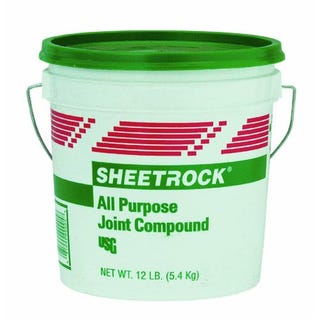
All Purpose Joint Compound, 1 Gal
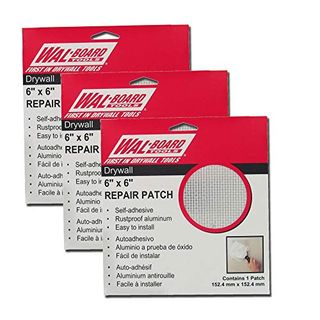

Stainless Steel Drywall Taping Knife
Warner Manufacturing
$10.48
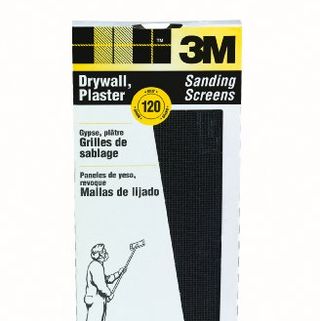
Know What Compound You Need
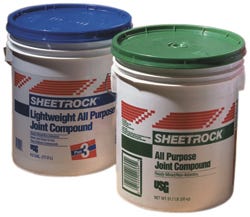
The two most common types of premixed drywall compounds—also known as spackle—are lightweight and all-purpose. The lightweight product weighs about a third less than all-purpose, it dries more quickly, and takes less effort to sand smooth. All-purpose compound dries harder and typically costs less.
Both types are easy to apply and have a shelf life at room temperature of about nine months. If you have drywall damage in several rooms, buy a 5-gal. bucket of compound. For smaller repairs, something like this will suffice.
Note that dry-mix joint compound is also available, which comes in powder form. It must be mixed with water to the proper consistency prior to application. Dry-mix compound is more affordable than the pre-mixed varieties, but pre-mix compound is easier and quicker to use for DIY repairs.
Doorknob Damage

Step 1. One of the most common drywall repairs occurs when a door is swung open a little too forcefully and the doorknob punches a hole through the drywall. The simplest way to fix the hole is with a peel-and-stick repair patch. The patch consists of an adhesive-backed aluminum screen that's reinforced by fiberglass mesh. Simply peel off the protective backing and press the patch over the hole.

Step 2. Use a 4- or 6-in.-wide drywall knife to apply joint compound over the patch. Be sure to apply enough pressure to force the compound through the mesh. After the compound dries, sand lightly and apply a second, thinner coat of compound, making sure to extend it a few inches beyond the first coat. Repeat a third and final time. When dry, sand lightly, then prime and paint.
Crumpled Corner Bead

Step 1. When two sheets of drywall meet at an outside wall corner, they're protected by an L-shaped metal strip called a corner bead. Corner bead is nailed over the corner and then concealed by two or three layers of joint compound. Metal corner bead is pretty tough stuff, but it's not indestructible.
It can get dented through any number of activities, including run-ins with the vacuum cleaner, a child flinging a toy, or when moving furniture. The good news is that ordinarily only a small section of the corner bead gets damaged, making the repair much simpler.
Begin by using a hacksaw to cut through the corner bead approximately 2 inches above and below the damaged section. Next, take a utility knife and cut along each vertical edge of the corner bead, making sure you slice through the paint and joint compound.
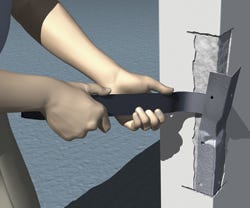
Step 2. Pry the severed piece of corner bead from the wall using a thin pry bar and straight-blade screwdriver. Try not to damage the surrounding drywall surfaces. Now, use aviation snips to cut a new piece of corner bead to replace the damaged section.
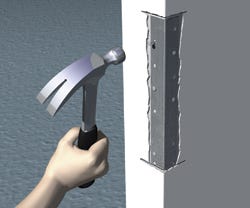
Step 3. Set the new piece into place and fasten it with 1½-in.-long drywall nails, which have very thin, flat heads that are easier to conceal with joint compound than drywall screws.
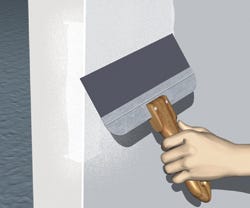
Step 4. Apply two to three coats of joint compound, making sure to sand between coats. Spread the final coat with an 8-in. drywall knife. When done, prime and paint to match the walls.
Creeping Cracks
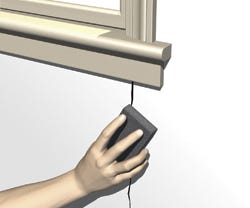
Step 1. Vertical drywall cracks will often appear above and below windows and doors. These hairline cracks are usually caused by lumber shrinkage and settling in the house frame. To repair the cracks, start by using a sanding sponge to sand the crack smooth. After sanding, vacuum the crack to remove all loose dust and debris.

Step 2. Next, use a narrow putty knife to apply a thin coat of joint compound to the crack. Wait for it to dry, then sand it smooth. Repeat, applying a second thin coat.
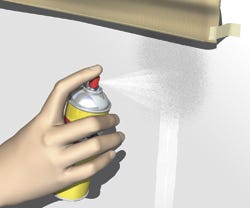
Step 3. To dissuade the crack from reappearing, spray the repair with a thin coating of elastic crack cover-up, such as Good-Bye Cracks.
Nails That Go Pop
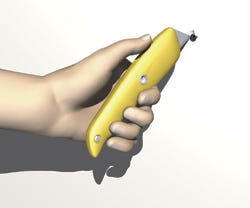
Step 1. Nail and screw pops are also caused from lumber shrinkage. To fix a popped nail or screw, start by twisting the tip of a utility knife into the wall to carve away the joint compound from the fastener head.
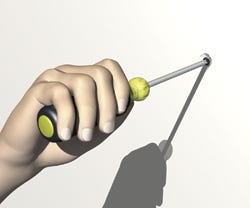
Step 2. Use a screwdriver to tighten the screw, driving it well below the surface. If it's a popped nail, use a hammer and nail set to tap it in deeper. If it feels as if the nail isn't hitting solid wood, yank it out with pliers and drive in a drywall screw, making sure you hit the center of the wall stud or ceiling joist.
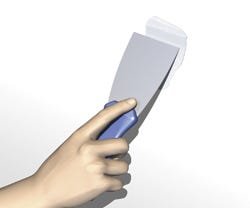
Step 3. Hide the repair using a drywall knife to apply three thin coats of lightweight joint compound. Sand between coats, then prime and paint.
Saggy Textured Ceilings
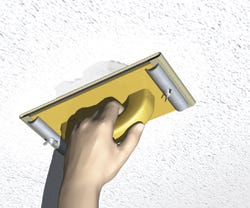
Step 1. Water damage will usually stain a drywall ceiling, but in some extreme cases, the drywall will actually sag down from the joists. This is a particularly tricky repair on a textured ceiling. Start by using a hand-sanding pad equipped with a sanding screen to remove the texture and smooth out the area.
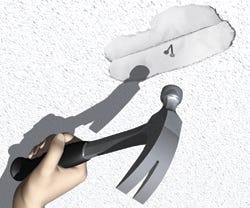
Step 2. Next, press the drywall up tight against the joist and secure it along the seam with drywall nails or screws driven into the center of the joist.
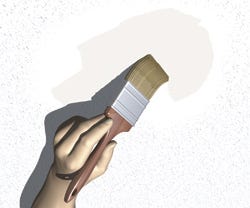
Step 3. Water stains will often bleed through standard primer. To prevent the stains from reappearing, brush on a coat of restoration primer, which is specifically formulated to block out the toughest stains.

Step 4. To blend in the repaired area with the surrounding textured ceiling, use a thick-nap roller to apply a thick mixture of drywall compound thinned with a little water.
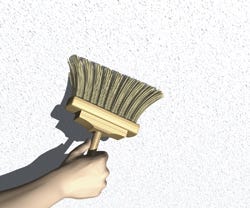
Step 5. Before the thinned drywall compound dries, add texture to the ceiling with a short-handled brush. If your ceiling has a popcorn texture, try concealing the repair with popcorn texture in a spray can.
Loose Inside-Corner Tape
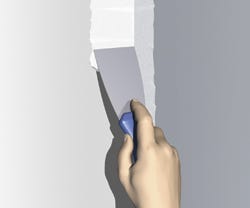
Step 1. Seams between sheets of drywall are hidden behind paper drywall tape and several thin layers of joint compound. Occasionally the paper tape will pull loose and peel up, especially in bathrooms where the tape is repeatedly exposed to hot, moist air. And this problem often occurs at inside wall corners.
While it's tempting to simply glue down loose tape, it's best to cut it out with a utility knife and replace it with a new piece of tape. After cutting away the loose tape, apply a thin bed of drywall compound to each wall in the corner.
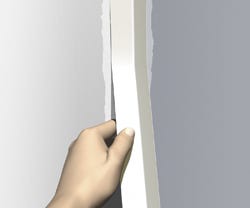
Step 2. Next, cut a new piece of paper tape to length, fold it lengthwise along its center crease, and press it into the wet joint compound.
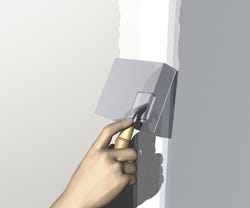
Step 3. You can press the tape into the compound and smooth it out with a 4-in. knife, but using an inside-corner knife makes the job much easier. This specialty tool smoothes both sides of inside corner at the same time.
Patching Large Holes
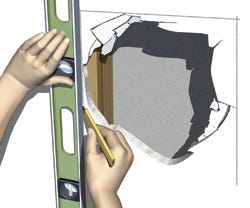
Step 1. To repair a large hole in drywall, first draw a square outline around the hole using a 24-in. level. As you mark the four lines, be sure to center one vertical line on the center of a wall stud.
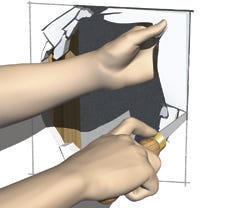
Step 2. Cut three sides of the square using a drywall saw, which is also called a jab saw because you start cutting by jabbing the saw's pointed tip through the drywall. Lift away the debris as you cut to keep it from falling into the wall cavity.

Step 3. Remove the drywall on the remaining side of the outline by using a utility knife to cut down the center of the stud.

Step 4. Cut a 1x4 pine board 6 to 8 in. longer than the square opening in the wall. Squeeze some construction adhesive onto the ends of the board.
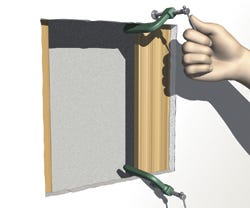
Step 5. Slip the 1x4 into the hole with the glued surface facing the back of the drywall. Position the board so it extends into the opening by at least 1½ in. Secure the board with two clamps.
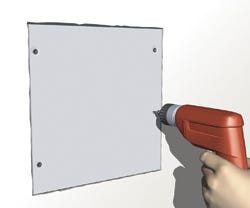
Step 6. After the adhesive dries, cut a drywall patch to loosely fit into the hole. Apply some construction adhesive to the exposed surface of the 1x4, then press the patch into place and secure it to the stud and to the 1x4 backing board with 1¼-in. drywall screws.

Step 7. Wipe down the wall and drywall patch with a slightly dampened sponge to remove any dust. Next, apply adhesive-backed fiberglass mesh drywall tape over the four seams of the patch. Overlap the tape at the corners for maximum strength, and center each piece directly over a seam. Firmly press down the tape for good adhesion.
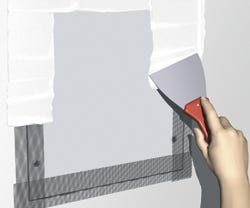
Step 8. Use a 4-in. drywall knife to apply the first layer of joint compound over the tape. Allow the compound to dry overnight.
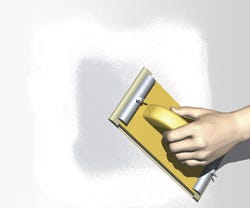
Step 9. Smooth the dried compound with a hand-sanding pad fitted with a sanding screen.
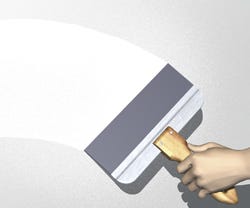
Step 10. Use an 8-in. knife to apply several skim coats of joint compound over the repair, making each one slightly larger than the preceding one. Sand the final coat smooth with 220-grit sandpaper. Finish by rolling on a coat of primer, followed by two topcoats of paint. And note that in some cases it might be necessary to paint the entire wall to ensure the patch is undetectable.
This content is created and maintained by a third party, and imported onto this page to help users provide their email addresses. You may be able to find more information about this and similar content at piano.io
How To Replace Drywall In Bathroom
Source: https://www.popularmechanics.com/home/interior-projects/how-to/a185/easy-drywall-repair/


0 Komentar